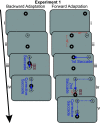Contextual saccade adaptation induced by sequential saccades
- PMID: 35171695
- PMCID: PMC8917932
- DOI: 10.1152/jn.00221.2021
Contextual saccade adaptation induced by sequential saccades
Abstract
Saccade adaptation is the gradual adjustment of saccade end point to maintain spatial accuracy. Contextual adaptation refers to a situation in which the adaptation-related change in saccade end point is contingent on the behavioral context in which the saccade is made. For example, in some situations, the same saccade to the same retinotopic location can be simultaneously adapted in opposite directions depending on the context in which it is made. Saccade adaptation has traditionally been studied in isolated movements, but in everyday life, saccades are often planned and executed in sequences. The oculomotor system may therefore have adaptive mechanisms specific to sequential saccades. Here, in five experiments, we investigated contextual saccade adaptation in sequences of saccades. In the first experiment, we demonstrate that saccades to a given retinotopic location can be simultaneously adapted in opposite directions depending on whether they occur in isolation or in a sequence. In the other experiments, we measured the extent to which properties of the previous and following saccades in a sequence can induce contextual saccade adaptation. Overall, we find that the existence, direction, and amplitude of previous and subsequent saccades, as well as the order of the current saccade within a movement sequence, can all induce contextual adaptation. These novel findings demonstrate the surprising flexibility of the system in maintaining end point accuracy, and support the idea that saccades made in a movement sequence are planned concurrently rather than independently.NEW & NOTEWORTHY This study reveals a new type of contextual saccade adaptation: sequential saccades are able to induce contextual saccade adaptation when direction, amplitude, or the existence of preceding and following saccades are used as contexts. These novel findings are also consistent with the idea that saccades made in a sequence are planned concurrently rather than independently.
Keywords: eye movement; saccade; saccade adaptation; saccade sequence.
Conflict of interest statement
No conflicts of interest, financial or otherwise, are declared by the authors.
Figures








References
-
- McLaughlin SC. Parametric adjustment in saccadic eye movements. Percept Psychophys 2: 359–362, 1967. doi:10.3758/BF03210071. - DOI
-
- Kommerell G, Olivier D, Theopold H. Adaptive programming of phasic and tonic components in saccadic eye movements. Investigations of patients with abducens palsy. Invest Ophthalmol 15: 657–660, 1976. - PubMed
Publication types
MeSH terms
Grants and funding
LinkOut - more resources
Full Text Sources

